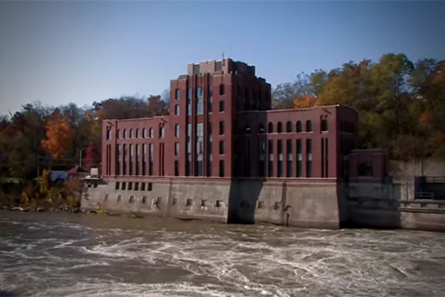When designing water conveyance systems for some of the world’s largest cities, engineering firms turn to research and expertise at the University of Iowa’s IIHR–Hydroscience and Engineering.
IIHR is a world-renowned research center in hydraulic engineering and fluid mechanics at the UI College of Engineering, with extensive experience constructing physical models that help solve water issues. The center’s past projects include systems in London, Abu Dhabi, Toronto, Indianapolis, and Washington, D.C.
Most recently, IIHR researchers were tapped by Jacobs Engineering Group to create a 1:16 scale model of part of a new sewer collection system in St. Louis, Missouri. The model was built at the UI to test and validate the design of various underground tunnels for the Metropolitan St. Louis Sewer District.
Troy Lyons, director of engineering services at IIHR, says when it rains in St. Louis, the city experiences overflows of its sewer system into rivers and streams because stormwater flows into the sewers and combines with wastewater there, quickly filling the pipes.
 About IIHR
About IIHR

IIHR—Hydroscience and Engineering is a world-renowned center for education, research, and public service focusing on hydraulic engineering and fluid mechanics. Based in the C. Maxwell Stanley Hydraulics Laboratory, a five-story red brick building on the banks of the Iowa River, IIHR is a unit of the University of Iowa’s College of Engineering. At IIHR, students, faculty members, and research engineers work together to understand and manage one of the world’s greatest resources—water.
Learn more at the IIHR website.
“Basically, the system can’t keep up with the inflow of water,” Lyons says.
The new tunnel system will provide is a way to intercept that water once it gets beyond the capacity of the existing system by diverting it to temporary underground storage tunnels, he says.
Lyons says designing better ways to manage combined sewer overflow systems is important because it prevents raw sewage from entering area waterways.
“And in large cities, where we see these types of systems being built, they are typically resorting to deep underground tunnels because there’s no place near the surface to store these volumes of water,” he says.
That’s where IIHR expertise comes in. To get the water from street level to storage tunnels—typically 150 to 200 feet underground—the St. Louis sewer system will use vortex drop shafts, vertical shafts in which flow spirals downwards—a design that was standardized and patented by IIHR engineers in the early 1980s. These shafts allow water to travel deep underground in the most efficient way, while minimizing the amount of air that can build up in the process. This is necessary because if too much air is trapped underground, it can become pressurized and cause heavy manhole covers to shoot up into the air at street level.
When St. Louis’ new vortex drop shaft is completed, it will be the largest in the world.
UI professor of civil and environmental engineering Jacob Odgaard, who was among the IIHR engineers who developed the first standards for the vortex drop shaft, says being able to create and test physical models of these water systems is important because often there are local conditions that must be accommodated.
“Very often we are faced with three, four, five different options, and we’re not sure what to select,” Odgaard says. “Yes, we can do it numerically (on a computer), but you can’t really tell the difference. Here, you can see it.”
Odgaard says it has been very satisfying to see designs he has worked on utilized around the world. And with each new client, he says IIHR is able to employ UI students to work on real-world projects, from helping build physical models to calibrating software.
“It’s a win-win for everybody,” he says.